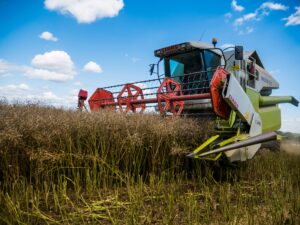Training at Claas: Protection of agriculture 4.0 with IP-design
In the realm of agriculture, a profound transformation is underway: Agriculture 4.0. This paradigm shift signifies the fusion of cutting-edge technologies with traditional farming practices, revolutionizing the way we cultivate crops and manage agricultural landscapes.

Feedback by Maik Manthey, CTO at CLAAS Group, after the training:
Were you aware of the scale of patent activities relating to digital and software-based solutions in Europe before the training course?
“Basic knowledge was available – but not in the depth and also not as concretely as it is pragmatically conveyed in the training. There is certainly in-depth knowledge in the respective specialist departments – the group of participants in the training consisted exclusively of digital experts and the training was an absolute enrichment for them.”
Is the patenting of the technical implementation of digital objects such as use cases, customer journeys or business models relevant for you and your company?
“Absolutely – many functions are based on very relevant use cases and can clearly be categorised as a competitive advantage. The customer journey is also a critical factor for success – we work on this discipline in a separate “User Experience” area – which certainly emphasises its importance.”
Were the case studies presented from the European industry vivid and clear to show the economic importance of digital patents?
“The case studies were really more than helpful – we were able to bring in relevant use cases as examples right during the training – and all participants could easily transfer the method.”
Has the role of patent infringements during the developement of digital solutions been made clear?
“Yes – it became very clear and at the same time it created even greater awareness.”
Was the DIN/ISO PDCA cycle explained and illustrated with practical examples?
“Yes – very impressive – with lively examples. There was also room to bring in your own examples, which made the topic very tangible.”
Was it shown how digital solutions can be made patentable with the help of patent types?
“Yes – and above all that the patterns can be used again and again in other combinations.”
Did you already have knowledge of this procedure in your company?
“Yes, the knowledge is available in the patent department – active participation in the training has greatly refreshed the awareness, which has become a central point in the digital transformation.”
At its core, Agriculture 4.0 embraces innovation to tackle the pressing challenges confronting the agricultural sector. With the integration of advanced technologies such as IoT, AI, robotics, and big data analytics, farmers are empowered with unprecedented insights and capabilities. Gone are the days of guesswork; now, farmers can make data-driven decisions in real-time.
Through the Internet of Things, sensors and devices are deployed across farmlands, gathering a wealth of information on soil conditions, weather patterns, and crop health. This data deluge is then processed using AI algorithms, unraveling valuable insights into crop management, pest control, and resource optimization.
Robotic systems have emerged as stalwart allies on the modern farm. From autonomous tractors to precision seeding drones, these machines execute tasks with unrivaled efficiency and accuracy. By automating labor-intensive activities like planting and harvesting, farmers can streamline operations and maximize productivity.
Precision farming lies at the heart of Agriculture 4.0, epitomizing the marriage of technology and sustainability. By precisely calibrating inputs such as water, fertilizers, and pesticides, farmers can minimize waste while maximizing yields. This targeted approach not only enhances productivity but also reduces environmental impact, fostering a more sustainable agricultural ecosystem.
The advent of Agriculture 4.0 heralds a new era of possibility for farmers worldwide. Armed with advanced technologies and data-driven insights, they stand poised to navigate the complexities of modern agriculture with confidence and resilience. As the agricultural landscape continues to evolve, Agriculture 4.0 paves the way for a future where innovation and sustainability converge to nourish our planet and its growing population.
About Claas
 CLAAS has already set the course for further growth into the future. The continuing digitalisation of agriculture is opening up many new potential innovation areas for the company. CLAAS has more than 40 years’ experience in the field of agricultural electronics. Its first electronic driver assistance system was introduced in 1974, in the DOMINATOR 85/105. The “grain loss monitor” (DKG) showed the driver how fast the machine could be driven without exceeding the grain loss ratio defined as acceptable. Today, combine harvester performance is optimised by fully automated assist systems such as the CEMOS AUTOMATIC, completely automatically and more efficiently than was ever possible before.
CLAAS has already set the course for further growth into the future. The continuing digitalisation of agriculture is opening up many new potential innovation areas for the company. CLAAS has more than 40 years’ experience in the field of agricultural electronics. Its first electronic driver assistance system was introduced in 1974, in the DOMINATOR 85/105. The “grain loss monitor” (DKG) showed the driver how fast the machine could be driven without exceeding the grain loss ratio defined as acceptable. Today, combine harvester performance is optimised by fully automated assist systems such as the CEMOS AUTOMATIC, completely automatically and more efficiently than was ever possible before.
Yet this technology represents only the beginning of a trend with dramatic impacts on the entire farming sector. Digitalisation and connectivity are bringing a fundamental transformation in agriculture and agricultural machinery, all around the world. This includes farm management systems to make the job easier, machines connected in intelligent networks, and fully digitalised process chains to make farming more efficient, and at the same conserve natural resources. The harvesting of data and information is clearly going to play a key role in this context.
As early as 1994, CLAAS established the AGROCOM business unit, into which the then leading provider of farm software, Klöpper & Wiege, was successfully integrated a few years later. CLAAS has now bundled all its electronics capability in a new subsidiary, CLAAS E-Systems. The new electronics centre in Dissen, Lower Saxony, has been working on developing innovative solutions for the high-tech farming of the future since 2017. With the launch of 365FarmNet, an open farm management software platform, not tied to any particular manufacturer, CLAAS is sending a clear signal that, in the “Farming 4.0” environment, the future of the agricultural sector lies in systems connected across competitor boundaries.
Machines will still be bringing in the harvest in the year 2100, but the crucial requirement will be to find the right combination of mechanical engineering and intelligent electronics. CLAAS will hold true to its fundamental principles, of never resting on its laurels, staying flexible and always keeping its feet on the ground.
The great advantages for the farmers
 Agriculture 4.0 heralds a new era of opportunity for farmers, ushering in a host of benefits that redefine agricultural practices. Harnessing cutting-edge technologies, it transforms farming into a more efficient, sustainable, and profitable endeavor.
Agriculture 4.0 heralds a new era of opportunity for farmers, ushering in a host of benefits that redefine agricultural practices. Harnessing cutting-edge technologies, it transforms farming into a more efficient, sustainable, and profitable endeavor.
Firstly, enhanced efficiency is a cornerstone of Agriculture 4.0. Through the integration of IoT devices and AI algorithms, farmers gain real-time insights into their operations, enabling them to make informed decisions swiftly. This proactive approach minimizes downtime and resource wastage, maximizing productivity across the farm.
Precision farming is another boon bestowed by Agriculture 4.0. By leveraging data from sensors, drones, and satellite imagery, farmers can tailor their interventions to specific field conditions. This targeted approach optimizes inputs like water, fertilizers, and pesticides, resulting in higher yields and improved crop quality while minimizing environmental impact.
Moreover, Agriculture 4.0 drives cost reduction through automation and optimization. Robotic systems and autonomous machinery take on labor-intensive tasks, freeing up valuable time and resources. By streamlining processes and reducing reliance on manual labor, farmers can significantly cut operational expenses, enhancing profitability in the long run.
Access to actionable insights is a game-changer for farmers in the era of Agriculture 4.0. Advanced analytics enable them to predict market trends, optimize planting schedules, and mitigate risks effectively. Armed with this knowledge, farmers can make strategic decisions that drive sustainable growth and resilience in the face of fluctuating market conditions and environmental challenges.
Ultimately, Agriculture 4.0 empowers farmers to embrace innovation and adaptability in an ever-evolving landscape. By embracing technology-driven solutions, they can overcome traditional constraints and unlock new opportunities for growth, ensuring the continued prosperity of agricultural communities worldwide. How to protect such digital solutions with IP-design was also the topic of a training by Prof. Alexander Wurzer at Claas on 16.01.2024.
A recent case study shows how the farmers benefit from the smart farming.
Telematics, a fusion of telecommunications and informatics, revolutionizes how vehicles operate and are managed. This technology integrates GPS, sensors, and onboard telecommunication systems to gather and transmit real-time data. By leveraging telematics, businesses can track vehicle location, monitor driver behavior, and optimize fleet efficiency. This enhances safety, reduces fuel consumption, and lowers maintenance costs. Telematics also enables remote diagnostics, allowing for proactive maintenance and minimizing vehicle downtime. Beyond fleet management, telematics finds applications in insurance, where usage-based policies use driving data to adjust premiums. In agriculture, it aids in precision farming by providing insights into equipment performance and field conditions. Overall, telematics empowers industries to operate more intelligently, efficiently, and safely in our increasingly connected world.
The video below shows the use of smart technology for farmers, and how they benefit from the new technology:
Find out more on how to implement knowledge into your business with the help of one of our courses.



